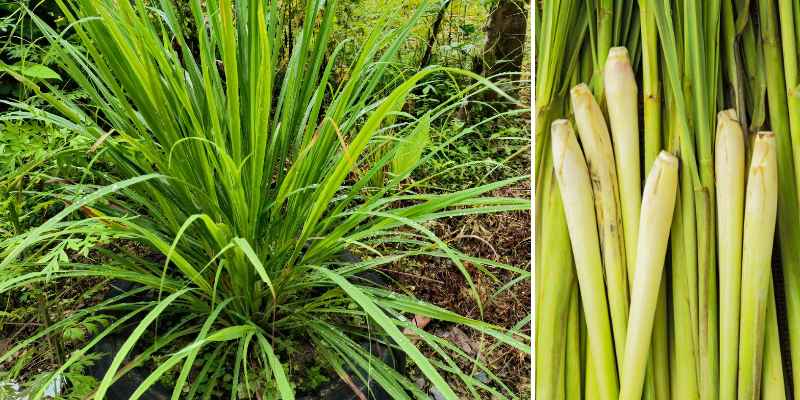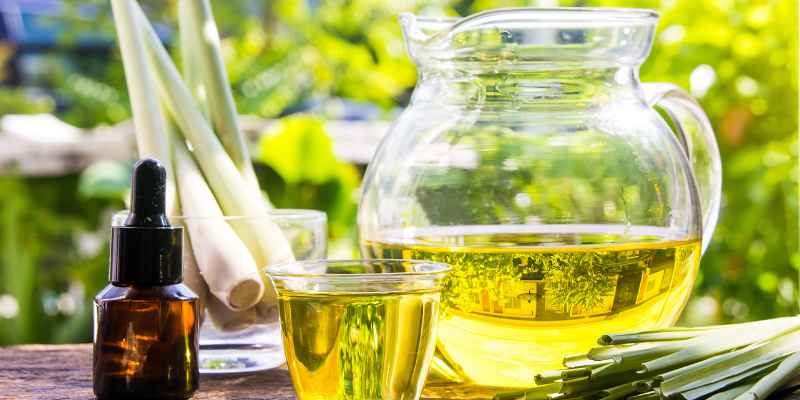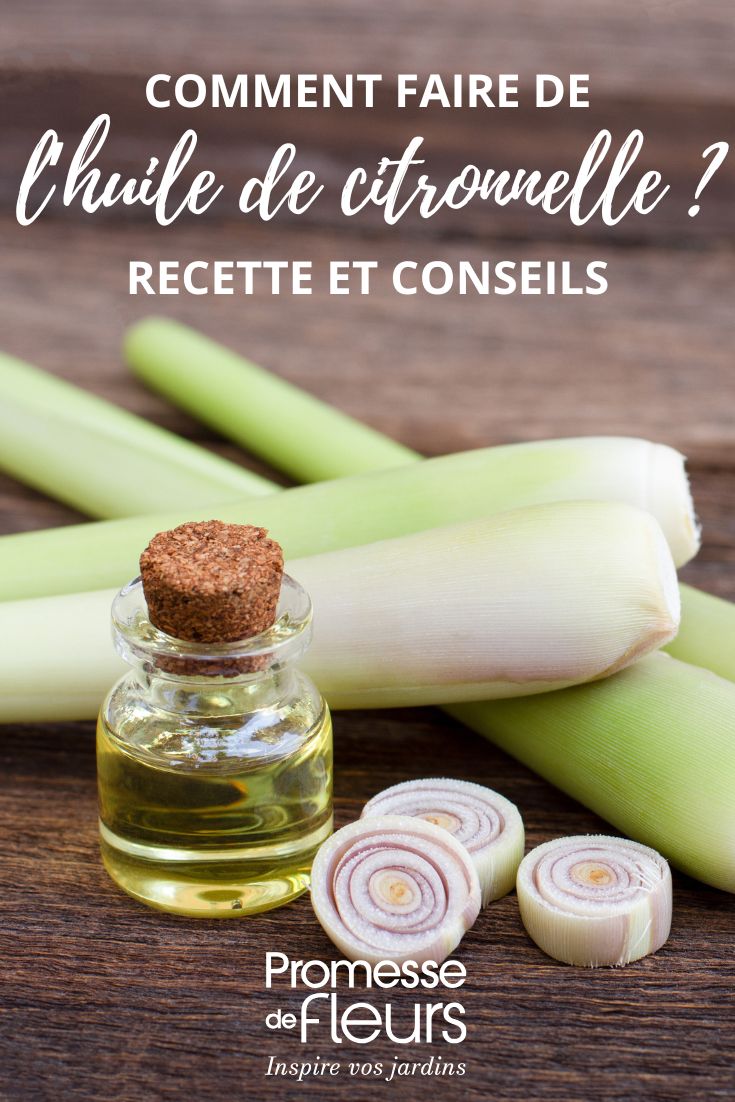With its numerous benefits and its unmistakably fresh fragrance, lemongrass is a highly valued plant for domestic use. While it is best known for naturally repelling mosquitoes, its virtues don’t stop there. It is also recognised for its soothing, toning, and mildly antiseptic effects, as well as its delicious lemony flavour in cooking, perfect for flavouring oils, marinades, or exotic dishes. This tutorial explains how to prepare a lemongrass-infused oil—not an essential oil—to easily enjoy its properties at home. Whether for skincare, culinary use, or as a natural repellent, this homemade oil fits naturally into a wellness routine or everyday dishes. Discover how to prepare lemongrass oil at home with our simple and quick tutorial!

Which lemongrass should you choose for homemade oil?
To make a good homemade lemongrass oil, it is recommended to use Madagascar lemongrass (Cymbopogon citratus), also known as Gabon lemongrass, Indian verbena, Java lemongrass, or lemon grass. This variety is particularly prized for its fresh, intense lemony fragrance, ideal for infusing into oil. Primarily, the stems and bulbs of the plant are used, as these parts contain the highest concentration of aromatic compounds. The bulbs, located at the base of the stems, are thinly sliced to release their natural oils, while the leaves can also be finely chopped and added to the infusion for an even richer fragrance. Freshly cut, the plant retains its active principles better, ensuring a more fragrant and effective infusion. Lemongrass is best harvested in late summer or early autumn, just before flowering, if grown outdoors. If the plant is grown indoors in a pot, stems can be harvested year-round, as long as they are well-developed, robust, and the bulbs begin to swell. The key is to harvest fresh, green, non-lignified stems with well-formed bulbs, as these contain the highest concentration of active principles for the oil.
Note: This does not refer to lemon balm (Melissa officinalis) or lemon verbena (Aloysia triphylla), although these can also be used to make infused oils. This tutorial focuses solely on lemongrass of the genus Cymbopogon.

Which vegetable oil should you use for successful lemongrass oil?
To make a lemongrass-infused oil, it is recommended to use a neutral, light vegetable oil that is easily absorbed by the skin. Sweet almond oil, grape seed oil, or even sunflower oil are perfect for capturing the aromatic and active compounds of lemongrass without altering its delicate fragrance.
How to make lemongrass oil step by step?
Equipment needed
- A sterilised glass jar with an airtight lid
- A clean glass bottle, preferably tinted to preserve the oil
- A fine cloth or sieve to strain the mixture
Ingredients
- 3 to 4 fresh lemongrass stems with their bulbs
- Approximately 200 ml of vegetable oil
Cold method:
- Wash the lemongrass stems and dry them thoroughly to avoid moisture in the oil.
- Thinly slice the bulbs to release maximum aroma.
- Finely chop the leaves if using them.
- Place the lemongrass in a clean jar.
- Completely cover with the chosen vegetable oil.
- Seal tightly and let it infuse at room temperature, away from light, for two to three weeks, gently shaking the jar every two days.
- Strain the oil using a sieve or fine cloth.
- Transfer the strained oil into a clean bottle, preferably dark-coloured.

Hot method (quicker):
- Clean the lemongrass stems and bulbs, then slice them finely.
- Crush them.
- Place the pieces in a pot with the oil.
- Heat on very low heat for about an hour, without boiling.
- Let it cool and strain.
- Transfer the strained oil into a clean bottle.
My tip: The oil is ready to use once it has completely cooled. However, it is advisable to let it rest for a few hours or overnight in its bottle to allow the aromas to stabilise before use.
What are the benefits and virtues of homemade lemongrass oil?
Lemongrass-infused oil is best known for its ability to effectively repel mosquitoes. It is also recognised for its soothing properties in case of itching caused by insect bites. Applied in a light massage, this oil can provide a pleasant sense of relaxation and ease mild muscle tension thanks to its gentle anti-inflammatory properties.
How to use lemongrass oil?
Lemongrass oil offers several uses in both cosmetics and cooking. As a natural cosmetic, it is particularly valued for its mosquito-repellent properties and soothing effects. It effectively calms itching caused by insect bites while providing a refreshing sensation. Used in gentle massage, it also helps relax tired muscles and relieve minor tension. Added in small quantities to a homemade cream or body balm, it delicately perfumes the skin while adding a revitalising touch.
In cooking, lemongrass oil subtly flavours dishes with its pleasant lemony taste. It is especially suitable for flavouring marinades for fish or poultry, lightly enhancing a vinaigrette, or adding a fresh note to exotic salads or cold dishes. It is perfect for subtly enhancing a prawn and mango salad or a fresh fish ceviche like sea bream, cod, or sea bass.
To preserve all its flavour qualities and natural benefits, it is advisable to avoid high-temperature cooking and prefer its use as a final seasoning just before serving.

How to store your lemongrass oil properly?
To preserve all the properties and virtues of your homemade oil, it is recommended to store it in a tinted glass bottle, tightly sealed, away from light, heat, and moisture. Under these conditions, your lemongrass oil will keep easily for several months while retaining its aromatic and repellent qualities.
Precautions and dangers of lemongrass oil
Homemade lemongrass oil is generally well-tolerated, but it may cause skin reactions in sensitive individuals. It is advisable to perform a patch test on the inner elbow before first use on the skin.
For cosmetic use, avoid contact with eyes, mucous membranes, and sensitive areas. This oil is not suitable for babies, young children, or pregnant women without medical advice.
For culinary use, ensure you only use fresh, food-grade ingredients (untreated lemongrass, food-grade vegetable oil). Once strained, the oil can flavour dishes, marinades, or sauces, but it should be used sparingly, as an aromatic oil.
































Comments